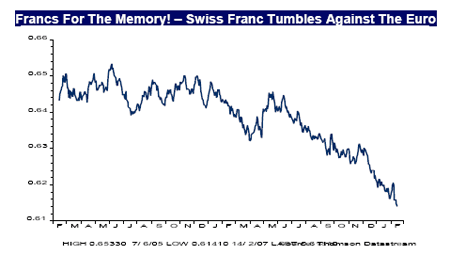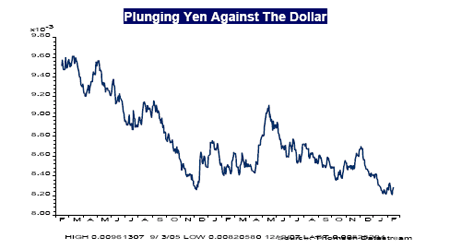In last week's Week In Preview article we considered the possibility of a shock of seismic proportions to the financial markets caused by indigestion stemming from the swathe of debt-funded acquisitions all the rage at present. This week we consider the threat posed by the other, and as some would see it, related financial market enormity all the rage at the moment, the carry trade. For those who blithely benefit from developed equity markets' inexorable ascent to new multi-year highs, without bothering to consider how carefully the ropes have been pinned to the mountainside, this particular piece of financial market chicanery might be regarded as a distant event with little practical significance. Inevitably, perhaps, we think not! The highly regarded Economist magazine wrote on February 10th that the carry trade could amount to as much as $1tr, a far from insignificant figure even in the context of today's highly valued markets.
What Is The Carry Trade?
At its simplest the carry trade involves borrowing money in an overseas currency with a lower interest rate than the currency of the host or originating investment and investing in higher yielding assets such as US or emerging market debt thus benefiting from the differential whilst substituting currency risk. Much has been made of investor preference for borrowing in low yielding yen, however, it is not the only currency to have become subjected to such activity.
The chart (below) shows the relationship between the euro and the hitherto "safe" Swiss Franc. So widespread has the carry trade phenomenon become that fully 92% of Hungarian home equity loans and around 70% of Polish housing debt are denominated in Swiss Francs. But, lo and behold! The naughty schoolboy who got away with shoplifting at the local sweet shop has had his misdemeanour masked by a tidal wave of naught schoolboys following suit. The currency risk that original carry traders thought they were taking on has suddenly become no risk at all. Suddenly everybody's doing it, driving borrowed currencies aggressively lower.
MoneyWeek
Subscribe to MoneyWeek today and get your first six magazine issues absolutely FREE

Sign up to Money Morning
Don't miss the latest investment and personal finances news, market analysis, plus money-saving tips with our free twice-daily newsletter
Don't miss the latest investment and personal finances news, market analysis, plus money-saving tips with our free twice-daily newsletter

The Swiss Franc carry trade
Before turning to the trials of the Japanese yen we should point out that the weakness of the Swiss Franc is extraordinary when one considers that its relationship with the euro should be stable given the commonality that exists between the two. The key difference is, of course, that the Swiss Franc has historically been regarded as a safe haven currency in a world of often wildly fluctuating currency movements elsewhere.
Traditionally, investors have paid a premium for this safety in the form of lower interest rates and the currency's performance on the foreign exchanges should be stable. The chart shows clearly that this is not the case. What should be a safe haven currency and a bolt-hole for those who fear financial market crisis has, itself, become caught up in the undertow of monstrous financial market rollers.
The Japanese Yen carry trade
Unlike the Swiss Franc, the Japanese yen has never been regarded as a safe haven. It has, however, become the world's most undervalued currency (see chart below). According to The Economist, based on research undertaken by JP Morgan, the Japanese currency recently fell to its lowest level since "at least 1970" on a trade-weighted basis, fell to an all-time low against the euro and, by some measures, is even cheaper than the Chinese renminbi. It had been suggested that the Feb 9th 10th meeting of G7 finance ministers, in Essen Germany, might have concluded with a communiqu calling for concerted action to lift the flagging currency. In the event what we got was another classic case of "a camel being a horse designed by committee"! There was no call for immediate action to revive the failing currency and it resumed its ongoing slide.

One justification for the absence of concerted desire on the part of the G7 lies in the fact that Europeans and the United States are, again, operating to different agendas. The Europeans see the yen's 40% "undervaluation" relative to the euro as posing a major threat to regional business and the sustainability of the steady improvement in regional economic activity. The US automotive industry shares those concerns, however, Treasury Secretary Hank Paulson (who has been applauded by us in earlier Week In Previews) continues to turn a blind eye, arguing that whilst the yen is weak, it is a function of a weak economy and low interest rates. This view contrasts with much deeper suspicion regarding the Chinese currency which the US sees as being supported by intervention.
Where Mr Paulson is, respectfully, wrong is that the Japanese currency should not, all things being equal, be weak. The country runs a massive structural current account surplus, boasts an economy now in its fourth consecutive year of growth and low inflation (note that deflation may be over). From an economic perspective the argument for Japanese base rates at just 0.25% is not strong, however, the ruling political party is under pressure, the prime minister is increasingly embattled and Bank of Japan governor Mr Toshihiko Fukui has, so far, shown few signs of being able to bring about increased independence.
The Bank of Japan's Monetary Policy Committee (MPC) meets again next week to decide on base rates. Despite another strong GDP growth figure over Q4 2006 (+1.2% quarter on quarter, +4.8% year on year) the MPC is expected, yet again, to keep rates on hold. Hedge funds are hardly likely to lose any sleep assuming that the glacial pace at which monetary policy is being tightened continues. Indeed it is generally regarded that Japanese base rates might need to rise by a full 2% before traders are forced to unwind positions and this seems highly unlikely. The counter argument to this is that a weakening US economy might cause the Federal Reserve to cut rates at the same time as the Bank of Japan increases rates, thus sharply narrowing the differential between the two. Back in 1998, in the wake of the Russian default crisis, the collapse of Long Term Capital Management and the then Japanese government's plan to recapitalise its deeply distressed banking sector, the yen rose by 13% against the dollar in just three days! A similar such recovery in the yen's fortunes, if seen as the precursor to a sea-change, might cause many a hedge fund manager to think twice
Emerging market crisis averted for now
The other thing investors need to be on the lookout for is the chance of currency instability emanating from crises bubbling up elsewhere in the world. Anything that results in increased volatility is likely to send a tremor through carry traders. To this end we note the potential threat posed by the possibility that Ecuador might fail to pay the interest on c$11bn net external debt. In the event Ecudaor, an oil exporter, has avoided default by agreeing to make the $135m coupon payment on a global bond during a thirty day grace period.
Investors should be under few illusions. Although Ecuadorian bonds trade at a c7.5% premium to JP Morgan's EMBI Index (according to the 14th Feb Financial times) and spreads barely moved in the wake of that country's decision (no great surprise as Ecuador was always able to pay had it so wished), the EMBI Index itself still trades close to record low yield differential with US treasuries. This is in itself disconcerting. The past few years has seen a mushrooming of financial instruments known as credit default swaps. These have been created to provide emerging market bond investors with some insurance against the possibility of default. As there have been no major emerging market defaults since Argentina 2001 these financial market "surf boards" have yet to be properly tested.
The carry trade: conclusion
The carry trade is in full swing for now, but an uptick in volatility levels could come from a myriad of different angles. Investors' lack of willingness to appreciate the risks posed by marked declines in the yen, the euro and ultra-low emerging market yield spreads are, to us, still blinking with the same special incredulity reserved for the sight of animals' apparently inexplicable desire to run for higher ground and the sea's sudden disappearance in the brief period immediately before a tsunami strikes.
By Jeremy Batstone, Director of Private Client Research at Charles Stanley
Get the latest financial news, insights and expert analysis from our award-winning MoneyWeek team, to help you understand what really matters when it comes to your finances.
MoneyWeek is written by a team of experienced and award-winning journalists, plus expert columnists. As well as daily digital news and features, MoneyWeek also publishes a weekly magazine, covering investing and personal finance. From share tips, pensions, gold to practical investment tips - we provide a round-up to help you make money and keep it.
-
 ‘Why I have ditched my Help to Buy ISA for cash savings and the stock market’
‘Why I have ditched my Help to Buy ISA for cash savings and the stock market’Without the 25% bonus, my Help to Buy ISA is effectively redundant, says MoneyWeek writer Sam Walker.
-
 Is your inheritance tax allowance cut if you sell to downsize or sell your home to pay for care?
Is your inheritance tax allowance cut if you sell to downsize or sell your home to pay for care?Downsizing relief is a little-known benefit that could save your loved ones tens of thousands of pounds in inheritance tax after you’ve died.

